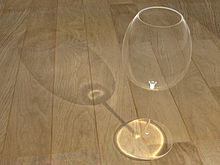Photon mapping
Photon mapping is a published by Henrik Jensen When 1,995 algorithm of image synthesis , which primarily as an extension of ray tracing -based method is used. The aim of photon mapping is to efficiently determine the global lighting of a scene and thus to generate realistic images in less time. Photon mapping is one of the particle tracing methods .
Procedure

With photon mapping, so-called “photons”, which transport a certain power ( radiation flow ), are “shot” from the light sources into the scene before the actual rendering process . Geometrically, this corresponds to ray tracing starting from the light source. A photon is largely abstracted through its position, the direction from which it is irradiated, and its radiation flow. If such a photon emanating from the light source hits a surface, it can be reflected , scattered , refracted , absorbed or stored in the photon map when it hits diffusely reflecting surfaces. This may change the power of the photon. The photon map (rarely: “photon map”) is a data structure that is independent of the scene geometry (mostly a three-dimensional k d tree ). The data stored in its photons can an estimate of the position of the photon at the incoming emit radiation flux. The entire process is called photon tracing.
The term “photon” used only agrees with the physical term insofar as radiation flux is transported. Photon mapping is not a quantum-physically correct simulation of the propagation of light. Instead, in photon mapping, a “photon” abstracts a large number of physical photons, the energy of which is added up to the output of the “photon” per unit of time. Quantum physical processes are not taken into account, since the geometric optics are usually sufficient to generate realistic-looking images .
The photon map created in this way can be used in various ways. The most common method is that during rendering, at each point at which a ray hits a surface during ray tracing, the indirect lighting is determined by the density and power of the photons in the photon map in the vicinity of the respective point. The global lighting of a scene can be determined by adding the indirect lighting determined in this way and the direct lighting determined by diffuse ray tracing . In addition, the Photon Map can be used to accelerate path tracing . For efficient simulation of caustics , these are saved in an independent caustic map .
It differs from other processes that work from the light source, such as light ray tracing or earlier particle tracing methods, in that the indirect lighting is only determined once in a single operation and is saved independently of the geometry.
For photon mapping there are other applications and extensions such as importon mapping and volume scattering .
support
Photon mapping is supported by most of the major renderers today. The most common renderer is Mental Ray , which is built into many large 3D software packages as standard. Other renderers such as POV-Ray , YafaRay , V-Ray , Maxwell Render and LuxRender also support photon mapping.
literature
- Henrik Wann Jensen, Realistic Image Synthesis Using Photon Mapping , AK Peters 2001, ISBN 1-56881-147-0 .
